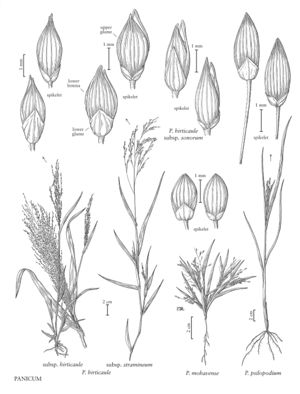Panicum mohavense
Plants annual. Culms 2-8 cm, erect-spreading; nodes 1-2, hispid; internodes pilose, hairs papillose-based. Sheaths rounded, much longer than the internodes, with prominent veins, hispid, hairs papillose-based; ligules 0.2-0.4 mm, membranous, ciliate; blades 1-4 cm long, 1-3 mm wide, flat or involute apically, glabrous basally, margins ciliate, cilia papillose-based. Panicles congested, partially included in the sheaths, less than 1.5 times longer than wide; branches ascending, narrow; primary branches appressed to the main axes, secondary branches and pedicels attached to the distal 2/3; pedicels appressed, 1-2 mm. Spikelets 2-2.2 mm long, 1-1.3 mm wide, plump-ellipsoid, glabrous. Lower glumes 1.2-1.3 mm, acute to attenuate; upper glumes and lower lemmas 2-2.2 mm, 7-9-veined, apices purplish, acute; lower florets sterile; lower paleas 0.2-0.4 mm; upper florets 1.4-1.8 mm long, about 1 mm wide, broadly ovoid.
Distribution
Ariz., N.Mex.
Discussion
Panicum mohavense is known only from arid limestone terraces in Arizona and New Mexico.
Selected References
None.
